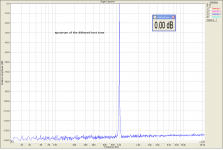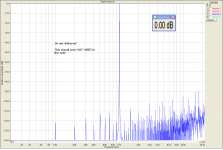Mooly, I have no answers for you. We talk at different levels. Sorry.
Mooly, you can go back to staring at the ground and drooling.
PMA any idea of where the sub-harmonic tones come from and if they are "there" in the original why would resampling make them go away? In a mathematical sense TPD dither applied to 16bit -6dB sin wave has no tones visible in 64K FFT.
200, 400, 800, 1400, 1800 yada yada subharmonics?
How was it dithered?
jn
One of my interests is in what is possible within the constraints of the situation - so, with a very basic digital file playback situation how far can the quality be pushed, in a positive direction, what are the factors influencing this - I certainly know, from plenty of experience(!!), how far the quality can be dragged in a negative direction, when using the most ambitious, expensive components!Such as a PC say with all that software running and gates switching
The most remarkable thing that has emerged is that the most mundane, unpromising equipment is capable of producing 'magic' sound, if sufficient effort and focus goes into optimising the playback environment, even if only for a short term period. And, yes, software can be part of that optimisation ...
I have plenty of CDs which I've got people to play on ultra-expensive, terribly ambitious systems - and they've barely got to first base in terms of unlocking the sound that I know is encoded on the disk. A confirmation, as if I needed one, that I'm going in the right direction is that the only systems out there that give me the "Ah hah! Now this is more like it!" moments are those with components that have been noted as being 'outstanding' by at least some observers ...
I've already mentioned why this is an "impossible" test, talk about loading the odds! Now, if the main track was an operatic aria, and the background add-in was Foo Fighters, doctored in precisely the same way, then it would be way more intelligent ...I'd be less skeptical if you (or anyone else) were able to show positive results on the Waslo Souza band test.
Re-reading your question, Mooly, I would say that I COULD (and do) live with sources that are compromised, BUT I would prefer better sources for serious component differentiation.
I watch cable TV and FM radio the majority of the time. They are NOT perfect sources, or even the best sources available, but I can and do enjoy them.
My associates (the people I work with) do less TV and radio, (except in their car) and rely on really high quality CD, DVD, SACD, and Vinyl records for their listening enjoyment. This is the best way (in my opinion) to hear listening differences.
I do not work with rating scores, so I cannot answer that part of the question. I hope this clears things up.
I watch cable TV and FM radio the majority of the time. They are NOT perfect sources, or even the best sources available, but I can and do enjoy them.
My associates (the people I work with) do less TV and radio, (except in their car) and rely on really high quality CD, DVD, SACD, and Vinyl records for their listening enjoyment. This is the best way (in my opinion) to hear listening differences.
I do not work with rating scores, so I cannot answer that part of the question. I hope this clears things up.
All that matters is changing one variable.
Reference state is normalized response, DUT result is difference. Ears may be used, but need very regular recalibration. Microphones are much more consistent.
Once again, I've never seen a system produce audible difference that doesn't also show measurable differences.
All transfer functions are equalizers.
Reference state is normalized response, DUT result is difference. Ears may be used, but need very regular recalibration. Microphones are much more consistent.
Once again, I've never seen a system produce audible difference that doesn't also show measurable differences.
All transfer functions are equalizers.
I have tried listening to amps without the use of any speaker cables. It removes a variable.
How to do this? Just place a power amp within a few inches of the speaker input terminals and make a very short jumper from amp output to speaker. A few inches.
Later, you can keep the amp a few inches from the speaker terminals and put a long cable between the amp output and speaker input. You can hear the affect of the amp/system with effectively no cable influence vs same amp with a cable.
Thx-RNMarsh
How to do this? Just place a power amp within a few inches of the speaker input terminals and make a very short jumper from amp output to speaker. A few inches.
Later, you can keep the amp a few inches from the speaker terminals and put a long cable between the amp output and speaker input. You can hear the affect of the amp/system with effectively no cable influence vs same amp with a cable.
Thx-RNMarsh
Last edited:
Later, you can keep the amp a few inches from the speaker terminals and put a long cable between the amp output and speaker input. You can hear the affect of the amp/system with effectively no cable influence vs same amp with a cable.
Cool. And the conclusion is? What cable, how long? I believe it is audible?
PMA any idea of where the sub-harmonic tones come from and if they are "there" in the original why would resampling make them go away? In a mathematical sense TPD dither applied to 16bit -6dB sin wave has no tones visible in 64K FFT.
HW resampler (DAC board), as I already explained. Original 1k test file is TPD dithered and clean. HW resampling (probably not dithered) makes that forest of spectral lines. As you know, spectrum of undithered 1k looks very similar. As I explained, DAC works only at 48kHz multiples for the reason of clock used and it resamples 44.1kHz.
Please do not ask me if i used the dithered tone for the test. Yes, I did.
All, please do not ask more trivial questions about dithering, at least not addressed to me.
All I want to explain is that if someone does not check his system he may not know what is really happening.
Attachments
Last edited:
Just place a power amp within a few inches of the speaker input terminals and make a very short jumper from amp output to speaker. A few inches.
Later, you can keep the amp a few inches from the speaker terminals and put a long cable between the amp output and speaker input. You can hear the affect of the amp/system with effectively no cable influence vs same amp with a cable.
Thx-RNMarsh
I assume soon you will be asked if you have proven this by scientific controlled double blind test with level matched at 0.01dB. If not, your conclusion will be stated as invalid
There must be at least 30 people in the listening room, best collected in the street nearby. >90% must hear and describe the difference according to Rec. ITU-R BS.1116-1, otherwise the result is invalid
Last edited:
Mooly, I have no answers for you. We talk at different levels. Sorry.
Lets see...
Mooly, you can go back to staring at the ground and drooling.
Sorry Mooly, I just don't understand what you are asking.
This thread is about hi end... yes, and your discussing the minutia of the design process and saying how much improved your designs are for using xyz cabling and xyz passives etc. But how quantifiable and real is that difference...
Use this as an example.
When it comes to IC's vs discrete, in my experience, discrete almost always wins.
EVEN when you use the same 'block diagram' same passive parts, same EQ, and the same care with buffering power supply voltages, etc, discrete comes out better. Not necessarily WAY BETTER, but better.
It was a real struggle for me to make the Parasound JC-3 (IC based) acceptable to both me and the listening public. AND different IC's swapped in the same position, sounded different. I just accept that it is the way it is, and move on.
So here, what I'm asking is how much of a difference (to you) you might score the JC-3 vs your IC based version. Subjectively, to listen too it. How close did it come.
JC-3 =100
JC-3 IC based = ???
That is what I was trying to get at earlier, just an idea of how you perceive the various levels in performance. I know its a skewed question because its just based on how you see and value changes in performance. The difference between your best and your worst might be 1% to you but that 1% might also mean the world to you.
Example.
JC's best 100
JC's worst 99
Best amp under £$1500 I've heard ??
Mr. Marsh, what was Your conclusions?
//
Mostly, how much more clean and accurate it sounds without the long cable attached between amp and speaker.....
-RNM
I'm sorry, Richard, you're not learning to use the correct language for these regions - what you meant to say is that you expected to hear cleaner and more accurate sound, because there was less of that nasty, visually ugly, and clunky cable ... and hence that's what you heard ...Mostly, how much more clean and accurate it sounds without the long cable attached between amp and speaker.....
-RNM
say Sugden Class A
One might hope this does not represent the state of affairs in the UK :
http://www.evmag.fr/images/zoom_Audio134-Sugden-MPA-4-Int.png
(sic Safco electrolytics, there's something I haven't seen in a while. Sugden in French kissing mood)
One might hope this does not represent the state of affairs in the UK :
http://www.evmag.fr/images/zoom_Audio134-Sugden-MPA-4-Int.png
(sic Safco electrolytics, there's something I haven't seen in a while. Sugden in French kissing mood)
One is not impressed
- Status
- Not open for further replies.
- Home
- Member Areas
- The Lounge
- John Curl's Blowtorch preamplifier part II

